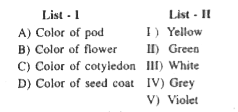Select the correct match :
Phytoplankton-Protozoa
Symbiosis-Lichen
Holozoic nutrition-Fungi
Autotrophs-Monerans .
The correct Answer is:B
Step-by-Step Solution:
1. Understanding Phytoplanktons: The first option states that phytoplanktons belong to protozoa. However, phytoplanktons are primarily composed of algae, diatoms, and dinoflagellates, which are classified under the kingdom Protista, not protozoa. Therefore, this option is incorrect.
2. Analyzing Symbiosis in Lichens: The second option mentions symbiosis in lichens. Lichens are indeed a symbiotic association between fungi and algae (or cyanobacteria). In this relationship, algae perform photosynthesis to produce food, while fungi provide water and minerals to the algae. This mutual relationship is well-documented, making this option correct.
3. Examining Holozoic Nutrition in Fungi: The third option claims that holozoic nutrition occurs in fungi. Holozoic nutrition is a characteristic of animals, not fungi. Fungi exhibit heterotrophic nutrition, which can be parasitic, saprophytic, or symbiotic. Thus, this option is also incorrect.
4. Evaluating Monodons as Autotrophs: The fourth option states that monodons are autotrophs. Monodons (likely referring to Monera) can exhibit both autotrophic and heterotrophic modes of nutrition. Therefore, stating that they are all autotrophic is inaccurate, making this option incorrect as well.
5. Conclusion: After analyzing all the options, the only correct match is option 2: symbiosis in lichens.
Final Answer: The correct match is option 2: Symbiosis - Lichens.
---
Topper's Solved these Questions
- KINGDOM FUNGI-MULTICELLULAR DECOMPOSERSBOOK - DINESH PUBLICATION ENGLISHCHAPTER - KINGDOM FUNGI-MULTICELLULAR DECOMPOSERSEXERCISE - CYG
19 Videos
- KINGDOM FUNGI-MULTICELLULAR DECOMPOSERSBOOK - DINESH PUBLICATION ENGLISHCHAPTER - KINGDOM FUNGI-MULTICELLULAR DECOMPOSERSEXERCISE - CYG
19 Videos
- INTRODUCTION BOOK - DINESH PUBLICATION ENGLISHCHAPTER - INTRODUCTION EXERCISE - CYG
10 Videos
- KINGDOM MONERA (THE PROKARYOTES)BOOK - DINESH PUBLICATION ENGLISHCHAPTER - KINGDOM MONERA (THE PROKARYOTES)EXERCISE - CHECK YOUR GRASP
20 Videos
Similar Questions
Select a correct match:
View SolutionSelect a correct match
View SolutionSelect a correct match
View SolutionSelect out the correct match
View SolutionSelect correct matching :-
View SolutionSelect correct match :

View SolutionSelect correct match:

View SolutionSelect correct matched pair/ pairs:
View SolutionSelect correct match

View SolutionMatch the following and select the correct option

The correct match is
View Solution
